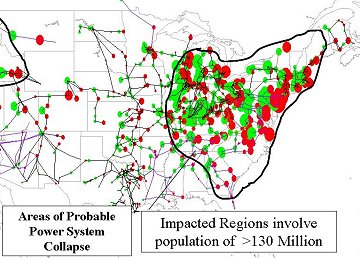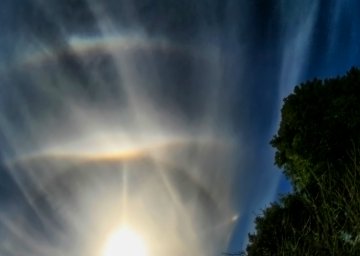| AURORA ALERT: Did you sleep through the northern lights? Next time get a wake-up call: Spaceweather PHONE. | | | NEW-CYCLE SUNSPOT: The first sunspot of the new year has appeared. Sunspot 1010 in the sun's southern hemisphere is a member of new Solar Cycle 24. Readers, if you have a solar telescope, take a look and witness sunspot genesis in action. POWER GRIDS IN PERIL: The National Academy of Sciences has released an important new report detailing how geomagnetic storms could damage the infrastructure of modern society. An area of particular vulnerability is power grids. Ground currents induced during century-class storms can actually melt the copper windings of huge, multi-ton transformers at the heart of some power distribution systems. Because modern power grids are interconnected, a cascade of failures could sweep across the country, rapidly cutting power to tens or even hundreds of millions of people: 
According to the report, "impacts would be felt on interdependent infrastructures with, for example, potable water distribution affected within several hours; perishable foods and medications lost in 12-24 hours; immediate or eventual loss of heating/air conditioning, sewage disposal, phone service, transportation, fuel resupply and so on." Melted transformers can take months to repair or replace--so a single extreme storm could make itself felt long after solar activity subsides. Nothing, it seems, is immune from space weather. (audio) Full report: Severe Space Weather Events--Understanding Societal and Economic Impacts (National Academy of Sciences) ICE HALOS: Clouds vex astronomers, but they're not always a bad thing. "The same high clouds that prevented me from seeing more Quadrantid meteors on the night of Jan. 3rd created a beautiful display of ice halos when the sun came up in the morning," reports Mila Zinkova of San Francisco, Californa. 
Among the network of arcs and loops, Zinkova identified "a 22o halo, a 46o halo, a Parry arc, an upper tangent arc and a sundog. I captured them all using my Canon Digital Rebel XTi." So, the next time vexacious clouds drift overhead, look around the sun. You may be pleased with what you see. more images: from Stuart Thomson of Maine; from Thomas M. Faber of Alpharetta, Georgia; from Matěj Grék of Lysá hora, Beskydy mountains, Czech Republic; from Jodie of Fort St John, British Columbia; from Andrea Tolman of Basin, Wyoming; from Gilbert Tennant of Hampton, Ontario; from Steve Yezek of Grafton, Iowa
Jan. 2009 Aurora Gallery
[Previous Januaries: 2008, 2007, 2005, 2004, 2001] | 
